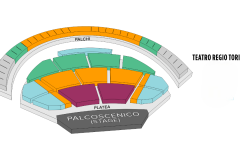The Puritans
May 2026 | ||||||
|---|---|---|---|---|---|---|
Mo | Tu | We | Th | Fr | Sa | Su |
The puritans | Vincenzo Bellini
In itself, the story of The puritans is quite simple: a love triangle, a contrast for political reasons, the threat of a tragedy, in this case narrowly avoided. But it is Bellini's music that makes the difference. Every human action, every conflict, every evil, is taken and transformed into long, celestial melodies, with a sinuous profile, which suspend time and have had a hypnotic effect on listeners since 1835. It does not matter that the story takes place in England: the composer's orchestra, perhaps thanks to his birthplace in Catania, maintains a Mediterranean light, the same one that fascinated Chopin and Wagner, and that was opening the doors of fame in Europe for him, before death closed them to him at just thirty-three years old. Among his operas, The puritans is perhaps the most refined in its instrumentation and the most varied in its characters: "the gay, the sad, the robust of the pieces, everything was marked by applause", wrote Bellini to his friend Francesco Florimo, the day after the premiere at the Théâtre-Italien in Paris. His last opera is being revived at the Regio conducted by Francesco Lanzillotta, who had already made a name for himself in Turin with Norma and La rondine, and sung by champions such as John Osborn, Gilda Fiume and Simone Del Savio. Pierre-Emanuel Rousseau, after his recent successes at the Regio with Il barbiere di Siviglia and La rondine, signs a new production for the occasion between classicism and neo-romanticism.
Program and cast
Overtitles in italian/english
OPERA SERIA IN THREE ACTS
Music by Vincenzo Bellini
Libretto by Carlo Pepoli
based on from the historical drama Têtes rondes et Cavaliers by Jacques-François Ancelot and Joseph-Xavier Boniface “Saintine”
Cast
Francesco Lanzillotta conductor
Pierre-Emmanuel Rousseau direction, sets and costumes
Gilles Gentner lighting
Guillemine Burin des Roziers assistant to sets
Ulisse Trabacchin chorus master
Orchestra and Chorus Teatro Regio Torino
New staging Teatro Regio Torino
Teatro Regio di Torino
The Teatro Regio di Torino is one of the oldest opera theatres in existence today: its origins date back to 1740, the year in which it opened as a magnificent venue of the Savoy Court. Designed by architect Benedetto Alfieri with innovative criteria, it soon became a destination of the grand tours of the period. After almost two centuries of uninterrupted activity, the old building, a theatre “all’italiana” with five tiers of boxes, was destroyed in a violent fire on the night between 8 and 9 February, 1936.
The fire did not interrupt the programming of the Regio, which continued in other theatres across the city until the opening of the present structure. Unique in all the world for its design, thanks to the genius of architect Carlo Mollino, it was inaugurated in 1973 with I Vespri siciliani by Verdi, in the one and only stage direction of Maria Callas and Giuseppe Di Stefano.
One Theatre, many proposals
The Teatro Regio offers a rich Opera and Ballet Season consisting of numerous operas, ballets and musicals. Together with the main Season there are also many other activities: symphonic-choral and chamber music concerts involving the Orchestra, Chorus and Children’s Chorus of the Teatro Regio; a series of shows staged at the Piccolo Regio Puccini and intended for schools and families; lectures, guided tours, exhibitions and special events realized in collaboration with the City of Torino and other institutions like MITO SettembreMusica. All events that put Teatro Regio at the centre of the cultural and artistic life of Torino, Piemonte and more.
How to arrive
By train
From both of the Torino train stations, Porta Susa and Porta Nuova, the Theatre can be reached by taxi (10 minutes) or on foot (about 20 minutes).
You can find your train to Torino at these internet sites:
Trenitalia
NTV-Italo
GTT-SFM
SNCF-TGV
By car
Depending on where you’re coming from, these are the main routes:
From the north and north-east
Motorway A4 Torino-Milano-Trieste or Motorway A5 Torino-Aosta, in both cases the exit is Corso Giulio Cesare
From the west
Motorway A32 Torino-Bardonecchia, exit Corso Regina Margherita
From the south and south-east
Motorway A6 Torino-Savona or Motorway A21 Torino-Brescia, exit Corso Unità d’Italia
Parking in the city center is by payment, both in the street and in the numerous underground car parks located near the Theatre:
Roma/San Carlo/Castello
Santo Stefano
Vittorio Veneto
Valdo Fusi
Please note that in Torino there is a Limited Traffic Zone (ZTL) that prohibits access to the city centre from 7.30 a.m. to 10.30 a.m. from Monday to Friday; some other streets are reserved for public transportation from 7 a.m. to 8 p.m. If you are staying in a hotel situated within the ZTL, the hotel can provide you with a pass to enter with your car.
Public transportation
The stops nearest to the Teatro Regio are:
Castello: lines 13, 15, 55, 56
Garibaldi: lines 4, 11, 27, 51, 57, Star2
The nearest stops of the Metro are at the train stations of Porta Nuova and Porta Susa (XVIII Dicembre).
Porta Nuova
Porta Susa (XVIII Dicembre)

 EN
EN DE
DE IT
IT FR
FR ES
ES RU
RU JP
JP RO
RO
 Seating plan
Seating plan 